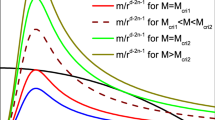Abstract
Infinitely cyclic cosmology is often frustrated by the black hole problem. It has been speculated that this obstacle in cyclic cosmology can be removed by taking into account a peculiar cyclic model derived from loop quantum cosmology or the braneworld scenario, in which phantom dark energy plays a crucial role. In this peculiar cyclic model, the mechanism of solving the black hole problem is through tearing up black holes by phantom. However, using the theory of fluid accretion onto black holes, we show in this paper that there exists another possibility: that black holes cannot be torn up by phantom in this cyclic model. We discussed this possibility and showed that the masses of black holes might first decrease and then increase, through phantom accretion onto black holes in the expanding stage of the cyclic universe.
Similar content being viewed by others
References
R.C. Tolman, Phys. Rev. 38, 1758 (1931)
R.C. Tolman, Relativity, Thermodynamics and Cosmology (Oxford University Press, London, 1934)
J. Khoury, B.A. Ovrut, P.J. Steinhardt, N. Turok, Phys. Rev. D 64, 123522 (2001). hep-th/0103239
P.J. Steinhardt, N. Turok, Science 296, 1436 (2002)
P.J. Steinhardt, N. Turok, Phys. Rev. D 65, 126003 (2002). hep-th/0111098
L.A. Boyle, P.J. Steinhardt, N. Turok, Phys. Rev. D 70, 023504 (2004). hep-th/0403026
P.J. Steinhardt, N. Turok, Science 312, 1180 (2006). astro-ph/0605173
M.G. Brown, K. Freese, W.H. Kinney, J. Cosmol. Astropart. Phys. 0803, 002 (2008). arXiv:astro-ph/0405353
L. Baum, P.H. Frampton, Phys. Rev. Lett. 98, 071301 (2007). hep-th/0610213
X. Zhang, arXiv:0711.0667 [hep-th]
X. Zhang, Eur. Phys. J. C 59, 755 (2009)
R.R. Caldwell, M. Kamionkowski, N.N. Weinberg, Phys. Rev. Lett. 91, 071301 (2003). astro-ph/0302506
A. Ashtekar, T. Pawlowski, P. Singh, Phys. Rev. D 73, 124038 (2006). gr-qc/0604013
A. Ashtekar, T. Pawlowski, P. Singh, Phys. Rev. D 74, 084003 (2006). gr-qc/0607039
A. Ashtekar, AIP Conf. Proc. 861, 3 (2006). gr-qc/0605011
P. Singh, K. Vandersloot, G.V. Vereshchagin, Phys. Rev. D 74, 043510 (2006). gr-qc/0606032
Y. Shtanov, V. Sahni, Phys. Lett. B 557, 1 (2003). gr-qc/0208047
E. Babichev, V. Dokuchaev, Yu. Eroshenko, Phys. Rev. Lett. 93, 021102 (2004). gr-qc/0402089
P.F. Gonzalez-Diaz, Phys. Rev. Lett. 93, 071301 (2004). astro-ph/0404045
L. Randall, R. Sundrum, Phys. Rev. Lett. 83, 3370 (1999). hep-ph/9905221
L. Randall, R. Sundrum, Phys. Rev. Lett. 83, 4690 (1999). hep-th/9906064
M. Bojowald, Phys. Rev. Lett. 100, 221301 (2008). arXiv:0805.1192 [gr-qc]
R.R. Caldwell, Phys. Lett. B 545, 23 (2002). astro-ph/9908168
B. Feng, X.L. Wang, X.M. Zhang, Phys. Lett. B 607, 35 (2005). astro-ph/0404224
X. Zhang, Y. Ling, J. Cosmol. Astropart. Phys. 0708, 012 (2007). arXiv:0705.2656 [gr-qc]
C. Gao, X. Chen, V. Faraoni, Y.G. Shen, Phys. Rev. D 78, 024008 (2008). arXiv:0802.1298 [gr-qc]
V. Faraoni, C. Gao, X. Chen, Y.G. Shen, Phys. Lett. B 671, 7 (2009). arXiv:0811.4667 [gr-qc]
H.H. Xiong, Y.F. Cai, T. Qiu, Y.S. Piao, X.M. Zhang, Phys. Lett. B 666, 212 (2008). arXiv:0805.0413 [astro-ph]
P. Martin-Moruno, Phys. Lett. B 659, 40 (2008). arXiv:0709.4410 [astro-ph]
Author information
Authors and Affiliations
Corresponding author
Rights and permissions
About this article
Cite this article
Zhang, X. Can black holes be torn up by phantom dark energy in cyclic cosmology?. Eur. Phys. J. C 60, 661–667 (2009). https://doi.org/10.1140/epjc/s10052-009-0967-5
Received:
Revised:
Published:
Issue Date:
DOI: https://doi.org/10.1140/epjc/s10052-009-0967-5




